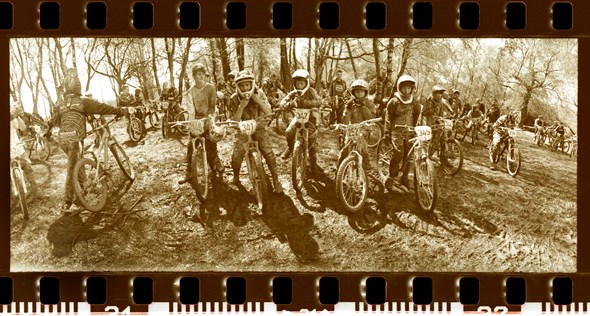
Geoff Waugh is a multi-award winning sports and adventure photographer who specialises in cyclesport of all disciplines. When he’s not in shooting a road bike race from a muddy Belgian ditch he can be found up a mountain photographing downhill bikers or at a velodrome with the track racers.
We sat down with Geoff recently to find out more about what it takes to be a sports photographer…
When did you become interested in photography?
I went to art school but I was only really good at drawing and painting. I think I came away with an A level but no qualifications. Then I was in a band and I thought I was going to be a pop star, that didn’t work either. Then I got a job at IPC magazines and probably the second day working there they asked me “can you take a picture?” and I said “yeah, probably”. They had a drawer with some Nikon FM cameras in them and they just gave me this camera. As soon as I could take it home and play with it I just thought: “this is fantastic”. I actually took my first published picture when I was working there from a roof garden at a bike race. I showed the pictures to the art editor and he said “why don’t you sell them?”. I’d never considered that and I just got a kick from seeing my picture on paper with my name by it. It just started there really.
After that I was out all the time, shooting whatever. And I bought my own little 35mm SLR with a 50mm lens and that’s all I had. I travelled to Spain and I just took loads of photos. I wouldn’t call it travel photography, I’d just call it reportage – even though that’s just a fancy word for taking pictures of stuff on holiday, travel snaps is probably more accurate. But you’re learning to use the camera all the time.
How did you get in to sports photography?
I’d just become aware of professional bike racing and thought these guys looked really cool and I got into taking pictures of bike racing to add to my portfolio because I wanted a mixed portfolio. So I basically blagged and begged and got into any sports event I could - I was shooting ice hockey, football and rugby. I started off going to a local park and shooting football there and then once I got this portfolio (of a sort) I started going around the newspapers. I think the first commission I had was from the Mail on Sunday for the rugby. After that I just couldn’t get enough of doing that sort of thing, It’s quite a buzz. Even though I wasn’t really into football, but going to a massive premier league stadium is quite a thing when you’re a little guy down on the touch line with thousands of people - the atmosphere is quite exciting really.
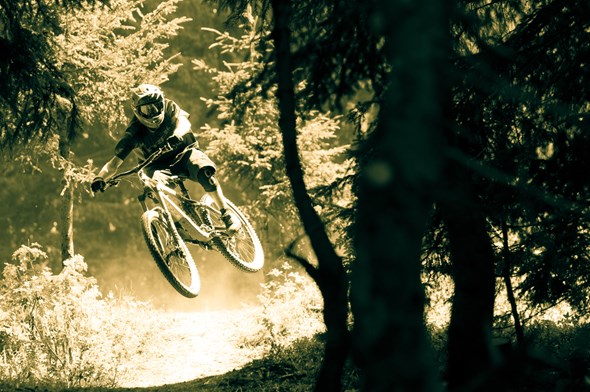
What is it about cycling and bike photography that you love?
Well with road cycling it’s definitely very, very colourful and goes through amazing scenery. I mean some people just watch the Tour de France on telly just to look at the scenery rather than the racing and I can really appreciate that. It’s very, very dramatic, unpredictable and easy to access - you don’t have to have accreditation to get good pictures because you can just wander up to the roadside. Even on the Tour de France you can get close to the roads, which is brilliant - you could never do that with Forumla One or football. So I enjoy that part of it.
I like mountain biking because I guess I like the getting dirty aspect. They’ve got a different outlook on what they do, it’s slightly more relaxed. It’s younger, so its freer and you can actually move around a lot more. Again, the scenery aspect too because a lot of the downhill mountain bike racing is held at ski resorts because they need chairlift access - you get so high up that the opportunities for pictures are many fold. It’s just a really cool thing to shoot.
More and more now I just like the outdoors aspect of it all, getting back to nature. I could never become a landscape photographer; it has to be action in a landscape. I’m not likely to camp on a hillside or get up at 4 o’clock in the morning for a sunrise. It’s what happens within that landscape and how I try to portray that to people who see my pictures. If I can make a mountain biker think “that trail looks amazing, I’d really love to ride that”, then my job’s done. If I can evoke some sort of emotion in the viewer, which is all it’s about really. Otherwise, it’s just a record.
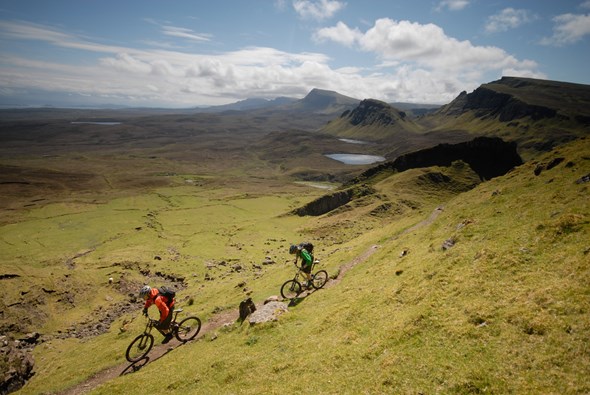
Is a lot of the work you shoot now still for magazines?
Predominantly, yes, but also for corporations. Because I’ve gone through the magazine route, people who actually make the bikes have seen my pictures and have asked me to shoot their media campaign or the launch of their 2012 bikes, which is great. There is a slight downside in that people think you’ve disappeared because they don’t see your pictures in the magazines any more so you become more anonymous.
Do you have a particular shot or composition in mind that you want to capture when you’re shooting an event or does sports photography tend to be quite spontaneous?
I’d say it’s both. It depends what it is, if I’m shooting a cover or a bike test then I’ll try and recce the location and I pretty much know what I want to do - I’ve got a brief and it has to be a certain way. At a race event that’s at a new venue then I’ll definitely look at it first and it will be almost shot freestyle. It’s pretty free-flowing but I like it.
In your area of photography you must find yourself in some pretty extreme and challenging shooting situations?
Yeah, in one day it can go from sunshine to snow. It’s as frustrating as hell because you have to take everything you need to cover that eventuality. I was in Austria a couple of years ago at a downhill race, where you have to shoot the whole thing but maybe there’s probably twenty racers that you actually want a picture of. I just sat on the ground in the pouring rain for 3 hours and it was actually hard to move after that because I was just so, so cold.
You get caught out as well, you think it’s going to be a blistering day and all of a sudden it changes. Football’s the same though, I can remember sitting on the goal line at Chelsea in a snowstorm and in a way it’s worse because you can’t move around, you can’t get warm. You have to sit in that one spot just getting frozen to the bone. It’s bonkers.
The worst thing is shooting in pouring rain. I was at the World Mountain Bike Championships at Fort William in Scotland, in 2007 I think it was. Photographers go to the top of the mountain to shoot the semi-final and they’ll go the bottom for the final to get the winner crossing the line and to shoot the celebrations. I decided to stay at the top for the final and I was inside a cloud. I was soaking wet and seriously concerned about my gear not working any more - my flashes and my PocketWizards (and they all did work, which was good) - but it was less than comfortable. The visibility was rubbish but the pictures were atmospheric because they looked like they were coming out of fog.
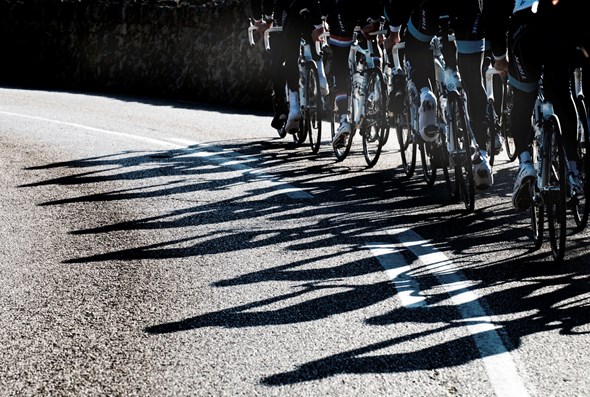
Your gear must have to be fairly resilient for the shooting situations that you need to be prepared for – are there any particular steps you take to keep it in good shape?
I just use freezer bags to put over my flashgun and a chamois leather for the camera. I have rain covers which are made of rip-stop nylon but I hate working with covers on my cameras because it’s really fiddly to get your hands inside and I feel a little bit hindered by them. It has to be really extreme before I start using those things. The cameras are fairly tough though. I have had flashes blow but it takes a lot of water inside to make them do that. Basically, I just put a chamois leather over the working electronics and over the lens and that’s pretty much it.
Do the type of environments you shoot in affect the type of gear you choose? Do you often go for the more weatherproof and hard-wearing products out there?
I’d say my bags are more what looks after my cameras rather than any real covers or anything. When you really need a cover is when it’s really muddy and a rider comes around the corner fast and you just get covered in mud. There’s nothing you can do about that but it’s just really frustrating when it hits the front element or the viewfinder.
What do you do in that situation?
I just have to clean it with the chamois, which works well enough. I always keep the lens hood on, I always angle the camera down and I always try to keep it out of the rain and that’s really about it.
If it’s really harsh like that I make sure the stuff I’m not using is inside my bag and very occasionally I’ll even use a poncho but you tend to get less pictures because you can’t be as active. It’s a compromise in keeping your gear protected and getting pictures.
That said, I really love epic conditions because they produce epic pictures. One of my goals is to get a cyclo-cross race in the snow. In fact it was one of the pictures that turned me on to cycling – it was a double page spread of a cyclo-cross race in the snow and it was a flashed picture and you could see the light reflecting on the drops and I thought, that looks insane! The pictures looked really gnarly and I thought, alright, I want a picture in snow.
You travel quite a bit, but are most of the cycling events you cover based in the UK?
Yeah, they are. Two years ago I followed the whole Mountain Biking World Cup (apart from North America) shooting for a company, which included Italy, France, Spain, Germany. I love it but it is hectic, there’s a lot of logistics to work out before you even go, just to get it planned.
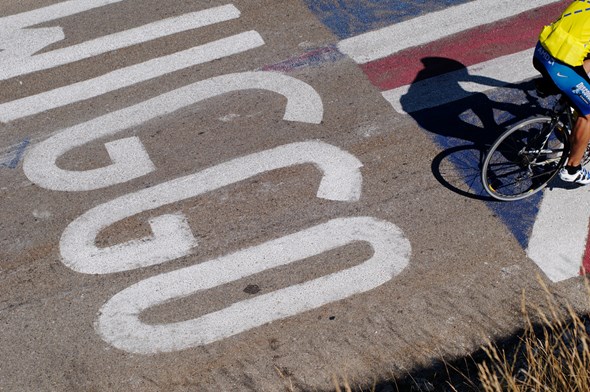
Do you carry a lot of gear with you when you’re off to an event?
Yeah, I carry as much as I can sneak on to the plane. I think most photographers get the knack of making their backpack look lighter than it is. I do carry a lot of gear but I’ve whittled it down. I’ve got lighting stands that are really small that will fit into my clothing luggage so I can put them inside there and I can put my flashguns inside there…and then just hope it doesn’t all get weighed.
What do you always have in your camera bag on a job?
I would definitely have my two Nikon D300s bodies. I would have a 17-55mm lens, 70-200mm lens, 12-24mm lens, a fisheye lens, possibly a 50mm, two flashguns and PocketWizards and various other things – cards, cables and other essentials you need. If I’m in my car then I’ll take my 300mm f2.8 lens, Q Flash and light stands and the bigger stuff that I know I can move around quite easily on the road.
No one likes to carry loads of gear and it’s quite hard to get up and down the mountain with it, so you strip it back to what you think you’re going to need to get the job done. There was a fashion to use off-camera flash and now that cameras are so good at high ISO that fashion is slowly, slowly going to die out I think.
Most photographers I know would really just like to carry one camera and one lens because then you’re that much more mobile. In fact, sometimes the guys who’ve been doing it for ages on the circuit will say “right, we’re going to have a 50mm challenge day today” and you’re only allowed to shoot with a 50mm. It’s quite fun, it makes you think again!
Do you rely on any support (a tripod or monopod) or do you shoot pretty much all handheld?
I used to use a monopod for football and things like that because you’re stuck in one place all the time. I would use a tripod if I’m shooting a 24 hour Mountain Bike race, for example, when I want light streaks and long exposures. But generally, it’s too cumbersome. It’s too restrictive, too big and heavy to carry.
I have used a monopod for other things, like putting a flash on top and holding it out to give me an extra bit of height and even remote cameras – I’ve stuck a camera on the top of a monopod with a 50mm to get the crowd or different shots like that. So I’m not against actually carrying one as long as it’s a lightweight one.
You do some work with Lowepro (and you’re a Loweprofessional!) - which bag is your go-to choice at the moment?
The Flipside 500 AW, which was a limited edition bag that’s now gone into production. It’s such a great bag, it just swallows gear but it’s really, really comfortable. I can get my 300mm in there if I want to. It doesn’t have a laptop pocket but I can get my iPad and 13” MacBook into the front pocket when I’ve been travelling so it does take loads of gear. I can put two little tripods in the side pockets, which is fantastic. I’ve got a lot of bags, and this is generally the one I go to.
If I’m at a cross country event it’s not like being an ‘event photographer’ where you’re shooting each individual to sell them a print. I need to tell a story of the whole day, so I need to be all over the place. It’s actually pretty tiring, getting from one spot to the next, learning about all the shortcuts from the different positions. I carry the 500AW pretty much all the time and it’s such a good bag, it feels lighter than it really is.
For riding and shooting, Lowepro also have the Photo Sport 200 AW which is much lighter. In the past I used to do 8 hour rides on the mountain and it’s about getting water, food, clothing and cameras in there. So obviously you don’t take as much gear as you would on a normal shoot and I think Lowepro realise that, so they make this bag for guys like me who are active, outdoor people. So I can fit one body in there, maybe two lenses and a flash, with waterproofs in the top and it’s got a pocket for a water bladder. It’s made from rip-stop nylon so it’s really light and that’s been fantastic.
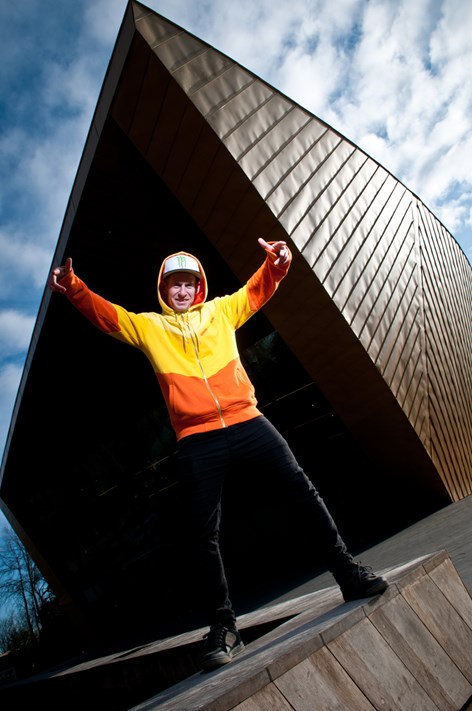
There are other bags I use too, like the Street + Field system. I’ll use that at races like the Tour of Britain Road Race or places like that where I can just put the harness on and my gear’s all ready in the pouches. I can just put my gear straight into the duffle bag and put it on just like a backpack, which means my cameras are all ready. I just need to put the harness on and I’m ready to go. It’s a really well designed system and you can carry an enormous amount of kit really.
I also use the Pro Roller x200 and if I’m doing a portrait, it’s perfect. I used it yesterday to shoot a guy and it’s got a little flash attachment on the handle, which is fantastic because I didn’t want to be bothered with lighting stands since I was working in the street. So I just pulled it up and mounted the flash and it was fantastic. It doesn’t go super-high but it goes high enough to make a picture look different.
So you do some portrait work as well?
Not conventional portraits but I do love doing lifestyle portraits that go with a feature, it usually is an athlete. If I shoot, say, a bike test, I like it because I’m controlling the shoot. At a race, I can’t tell the guys to go back and do it again!
The guy I photographed yesterday is a biker who’s developed his own clothing line so it’s more about him and he had his bike from the weekend which was absolutely still caked in mud so we used his bike in the shoot.
Do you have a favourite image from your career to date?
I’ve got one that I can think of, which is a guy I photographed from the Czech Republic who was World Trials Champion and we did a shoot in the Dominican Republic. He rode down the roof of this painted hut with really cool colours. There’s really blue sky and this guy is just on his front wheel rolling down the roof, so I got a picture of that. It was in the AOP exhibition that year and it was also around the time that digital was coming in and overtaking film and no one believed it! People didn’t know who he was and they thought I’d photoshopped it. For one, I don’t really know how to photoshop and two, he’s the world trials champion so he can do that, that’s what he does.
Those are the two elements that I remember - because it was a fantastic day and I came away with a really nice picture and I also felt a bit deflated because people didn’t believe that I took the picture!
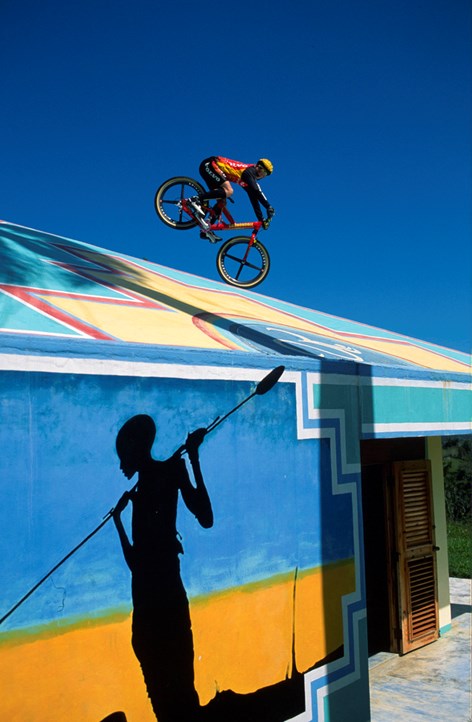
Do you have any advice for those keen on pursuing a career in sports photography?
I actually think it’s probably easier now than when I started because when I did it you’d have to market yourself and it all cost money. Whereas now, you can go on the web and you can market yourself through social media and you can make your website for nothing, so that’s all free. There were things that I didn’t know that seemed like a dark secret, and now you can just go on YouTube and find the answer, so I’d say it’s probably a really good time for that too.
I’d say to start doing what I did, which is to just go to your local park and practice shooting there. It’s not difficult really to get access to those things and then worm your way into the other places by hook or by crook.
Even inspiration-wise you can look at so many great images on Flickr and on 500px. If you don’t get inspired by that, you need help! There’s just so much out there.
When you’re not photographing bike events, are you passionate about shooting any other subjects?
What I do like to do is shoot film with a Hasselblad. It’s almost like relaxation and I love it and really enjoy doing it. That’s how I keep the passion going I think, it’s a process that keeps me in touch with a certain side of taking pictures.
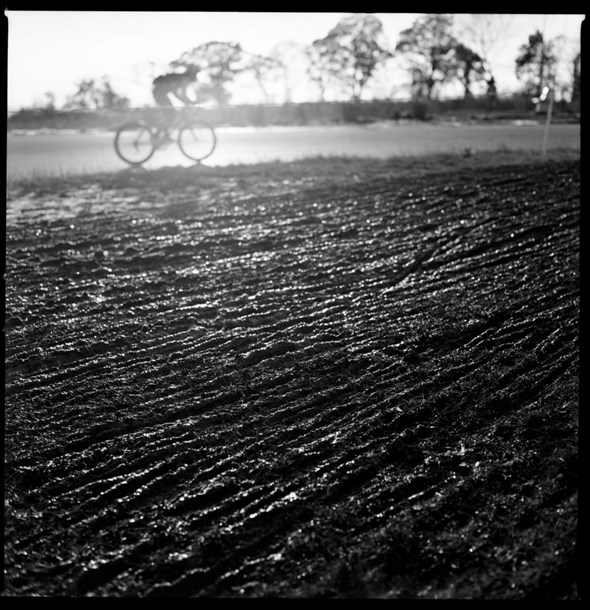
What’s next for you?
Right now I’m shooting a series of portraits of World Mountain Bike Champions with the rainbow jersey they get for winning. So, the most recent shoot I did was last month in Belgium and I collared as many world champions as I could there, got in touch with them beforehand and told them to bring their jersey so I could do this specific shoot. I did come away with some nice shots. That’s an ongoing thing and the next round will be in France in a couple of weeks so I’ll be going to that and then I’ll finish it at Fort William in Scotland. The first ones I’m doing are cross country discipline and the Fort William are downhill and I’ve got some plans for those guys to get them in different places really, get them a little more offbeat if I can. So I’m quite excited about that, for sure.
To find out more about Geoff’s work, visit http://www.waughphotos.com. He blogs at http://waughphotos.posterous.com/
